Abstract
Battery storage is nowadays considered a key component not only in off-grid applications but also in the context of grid-tied, residential-scale systems, facilitating the broader use of RES even in heavily congested distribution grids. Since batteries normally comprise the costliest part in similar configurations, their optimal sizing is a priority. Informed decisions to that end should not be limited to rough, initial-cost estimations alone; instead, they should also take into account the life-cycle costs of batteries, which, in turn, relate to battery aging mechanisms and the gradual, cycling-based fading of the batteries’ useful capacity. Acknowledging the above, the impact of battery cycling aging on the performance of typical, residential-scale, RES-based battery storage configurations is investigated herein, considering also the utilization of second-life lithium-ion EV batteries. To that end, we used a literature-informed empirical aging model and performed a simulation exercise for a broad set of different RES-battery configurations, with our results indicating the importance of the aging factor while also designating areas of optimum sizing with regard to the long-term energy and economic performance of similar solutions.
1. Introduction
Battery storage is nowadays considered a key component not only in off-grid applications but also in the context of grid-tied, residential-scale systems, facilitating the broader use of RES even in heavily congested distribution grids [1,2]. Since batteries normally comprise the costliest part in similar configurations, their optimal sizing is a priority. Informed decisions to that end should not be limited to rough, initial-cost estimations alone; instead, they should also take into account the life-cycle costs of batteries, which, in turn, relate to battery aging mechanisms and the gradual, cycling-based fading of the batteries’ useful capacity.
At the same time, increased interest has been recently demonstrated in retired EV batteries and their reuse for stationary storage applications, with a focus on the residential sector [3,4]. To that end, similar second-life EV batteries can make up for the increased capital costs otherwise introduced by the procurement of a new battery component, especially for RES-based configurations requiring the coverage of a high degree of energy autonomy, at the expense, however, of the batteries’ anticipated life expectancy.
Acknowledging the above, the impact of battery cycling aging on the performance of typical, residential-scale RES-based battery storage configurations is investigated herein, considering the utilization of second-life lithium-ion EV batteries. To that end, we use an empirical, literature-informed aging model [5] and perform a simulation exercise for a broad set of different RES-battery configurations, examining the long-term impact of the main parameters’ variations on both the energy and economic aspects of the problem investigated.
2. Materials and Methods
2.1. Problem Definition and Methods
In accordance with the above, the current study develops a computational framework for the evaluation of different prosumer schemes, capturing different RES-battery configurations (including both wind power and solar power on a residential scale) and incorporating an empirically informed battery capacity degradation model. For that purpose, we use a typical Greek household demand pattern and perform an extensive parametrical analysis concerning system size, focusing on the estimation of the anticipated life expectancy for typical second-life lithium-ion EV batteries.
The schematic block in Figure 1 synopsizes the problem methodology, which, apart from the variation in system main variables (Nw: wind power; Npv: PV power; ESS: BATTERY capacity), looks at the generation of key performance indices (KPIs), both energy and economic ones (see also Table 1), on the basis of hourly simulations (energy balance analyses) for a 20-year period and for each different configuration examined.
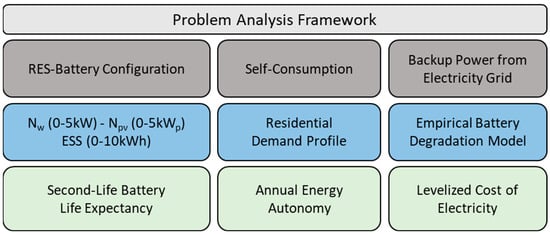
Figure 1.
Schematic representation of the formulated problem.

Table 1.
Key performance indices.
Accordingly, the approach adopted for the examination of the problem is the brute force approach, which assumes the study of all possible configurations within a given space of analysis, allowing, in this way, for the interpretation of emerging trends rather than the designation of unique, optimum solutions. To that end, the span of solutions currently examined considers 0–5 kW variation in wind and PV power (1 kW step) and 0–10 kWh variation in battery capacity (1 kWh step, DoD of 90%, and a moderate roundtrip efficiency of ~75%), which results in a total of 396 different configurations.
2.2. Input Data
For the purposes of our analysis, we use hourly time series of medium-quality solar potential of ~1580 kWh/m2.a at the horizontal plane and medium-quality wind potential with an annual average wind speed of 6.3 m/s (see Figure 2), representative of the Greek territory. Moreover, concerning the typical load demand pattern (see Figure 2c), we assume a residential end-customer determined by a moderate annual consumption of 3.5 MWh and a peak demand of 2.7 kW, and, in order to describe the degradation capacity of second-life lithium-ion EV batteries due to cycling, we draw empirical results from [5] and shape a normalized degradation curve given in Figure 2d. Finally, and with regard to electricity market prices, we use an hourly time series of spot prices from the Greek electricity market for the year 2021 (average price of 116 EUR/MWh), assuming that any energy deficits occurring on the household side are covered directly by the local grid, at the given hour spot price and with the additional inclusion of a 50% utility cap.
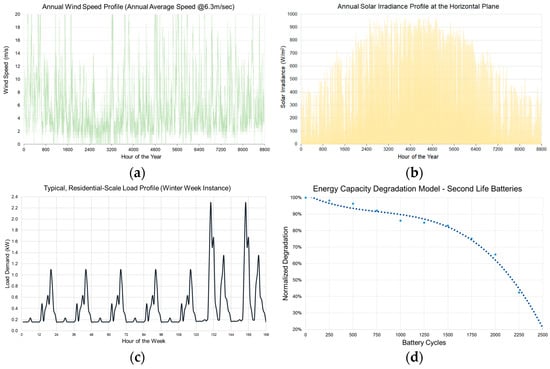
Figure 2.
Wind speed (a) and solar irradiance (b) profiles; weekly load demand variation instance for the typical end-consumer considered (c); and empirically informed degradation model of battery capacity for second-life lithium-ion EV batteries (d).
3. Results
By applying the proposed methodology, we can next proceed with the presentation of results of the brute force approach currently adopted. In Figure 3, we provide an exemplary instance of the long-term variation in the battery state of charge (period of 20 years) for two different configurations. In Figure 3a, we present the results for a limited-cycling-activity battery (capacity of 5 kWh combined with 1 kW of wind and 1 kW of PV power), and in Figure 3b, we present the results for an intense-cycling-activity battery (capacity of 2.5 kWh combined with 1 kW of wind and 1 kW of PV power). As can be seen from the two figures, the maximum state of charge in the batteries gradually fades and eventually reaches a minimum of 20%, which is currently assumed to signal the time of retirement for the battery component.
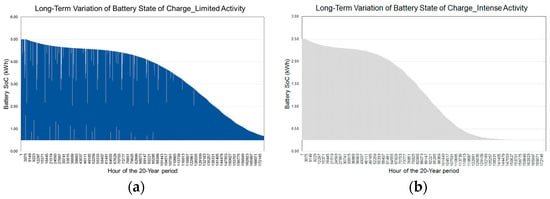
Figure 3.
Exemplary instances of battery capacity degradation under limited (a) and intense (b) cycling activity in a battery component over a 20-year period horizon of investigation.
In this context, the result of limited cycling, corresponding to the case in Figure 3a, leads to a 20-year lifetime period for the battery, although almost 50% of its available capacity is already lost by years 14–15. On the other hand, the intense cycling activity noted in Figure 3b leads to the retirement of the second-life lithium-ion EV battery (20% of original capacity available) by the 13th year of the 20-year period, which entails a 7-year period of reliance for the balancing needs of the end-user examined exclusively on the local electricity grid.
Accordingly, in the following set of figures (Figure 4, Figure 5, Figure 6 and Figure 7), we present the results of the brute force analysis for the entire range of configurations examined. Initially, in Figure 4, we isolate wind-only and PV-only configurations and examine the life expectancy (time of retirement) for the range of battery capacities examined (i.e., from 1 kWh to 10 kWh at steps of 1 kWh).
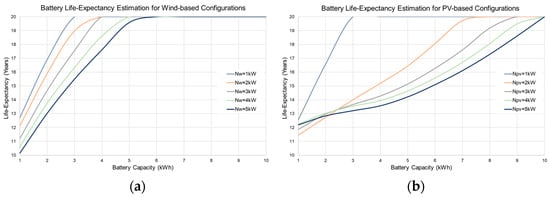
Figure 4.
Battery life expectancy for wind-only (a) and PV-only (b) configurations in relation to battery size and RES capacity variation.
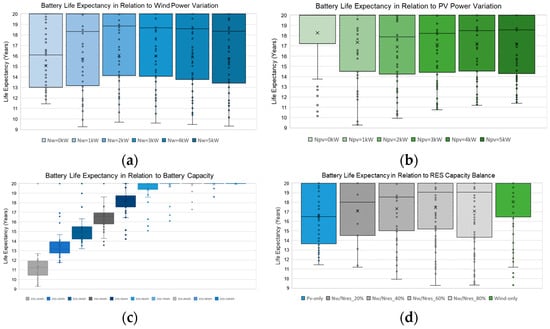
Figure 5.
Variation ranges of battery life expectancy in relation to variations in wind power (a); PV power (b); battery capacity (c); and the balance of RES capacity, i.e., wind power shares (d).
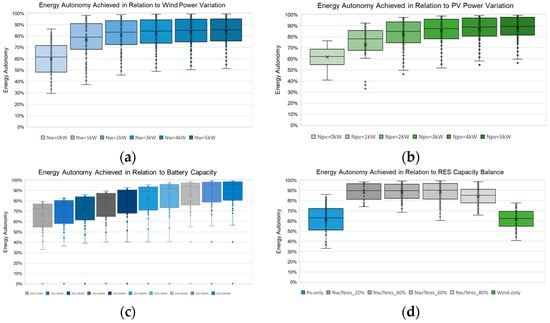
Figure 6.
Variation ranges of energy autonomy in relation to variations in wind power (a); PV power (b); battery capacity (c); and the balance of RES capacity, i.e., wind power shares (d).
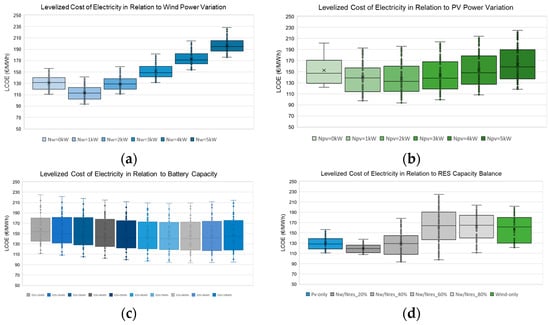
Figure 7.
Variation ranges of levelized cost of electricity in relation to variations in wind power (a); PV power (b); battery capacity (c); and the balance of RES capacity, i.e., wind power shares (d).
As expected, the increase in battery capacity leads to longer retirement times, while the same is valid for the reduction in RES power, with the exception of battery size values of up to 3 kWh in the case of the PV-only configurations. At the same time, and if excluding power values of 1 kW, more intense cycling in the case of PV-only configurations leads to an increase in the minimum requirements (almost double the battery size) in order to achieve a 20-year battery retirement. Moreover, in the set of boxplots presented in Figure 5, we provide life-expectancy results for all 396 configurations examined (not just wind-only and PV-only) in relation to variations in (a) wind power, (b) PV power, (c) battery capacity, and finally (d) the balance between wind and PV capacity shares, expressed by the ratio of Nw/(Nw + Npv).
To that end, from Figure 5a, it can be concluded that an increase in wind power up to 4 kW leads to relatively longer retirement periods, while the opposite seems to be valid in the case of Figure 5b, where an increase in PV power further than 1 kW leads to relatively lower retirement times. Moreover, as expected, an increase in the battery size signals a proportional increase in life expectancy, with battery capacity higher than 7 kWh achieving a 20-year period for almost all of the relevant configurations. Finally, in accordance with the results of Figure 5d, an increase in wind shares leads to longer retirement periods, with wind-only configurations presenting the highest life expectancy range (see also Figure 4a).
Next, using the same set of figures in Figure 6, we present energy autonomy results, again for all configurations examined. In this context, Figure 6a,b demonstrate the impact of wind and PV capacity increase, with the overall span of values ranging between 30% and ~100%.
The same pattern is shown in Figure 6c, where the battery-size increase beyond 7 kWh signals a significant increase in energy autonomy, with the respective ranges maintained between 55% to ~100%, justified on the basis of exploiting both a larger-size battery and longer retirement periods. Finally, and based on Figure 6d, it can be seen that the wind-only and PV-only solutions are limited in terms of energy autonomy, contrary to cases of more balanced RES systems, especially in the range of 20–60% of wind shares.
In addition, by integrating all cost components (assumed investment cost values of 1500 EUR/kW for wind power, 750 EUR/kW for PV power, and 200 EUR/kWh for second-life lithium-ion batteries, together with a 10% BoS and an annual maintenance coefficient of 3% over the system investment), we next present variation ranges for the LCOE in Figure 7.
To that end, minimum LCOE values appear for wind power of 1 kW (Figure 7a) and for PV power in the order of 2–3 kW (Figure 7b), with an increase in wind capacity shares (Figure 7d) beyond 20% and up to 60% leading to an increase in the LCOE. At the same time, it is interesting to note that battery size variation (Figure 7c) presents a minimum LCOE in the area of 7–8 kWh, which suggests that the given order of capacity achieves both a prolongation of the retirement time (see also Figure 5c) and an avoidance of battery oversizing. In the meantime, it is also interesting to note that minimum LCOE values across configurations appear in a range of ~100–130 EUR/MWh, which designates the contribution of second-life EV battery employment in reaching grid parity for similar solutions in the residential sector.
4. Discussion and Conclusions
In the present study, we investigated the impact of cycling aging for second-life lithium-ion EV batteries employed in residential, RES-driven configurations. In doing so, we adopted an empirically informed capacity degradation model that was next employed in an energy balance analysis exercise considering a broad set of wind power, PV power, and battery capacity configurations, alongside a typical residential-scale end-user demand profile and a medium quality RES potential. To that end, we examined the long-term performance of RES-driven, second-life EV battery storage configurations, determining the retirement period of different RES-based battery storage configurations together with the respective long-term energy autonomy and levelized cost of electricity. According to our findings, battery sizes in the area of 7–8 kWh achieve both the prolongation of the anticipated retirement time (see Figure 5c) and the avoidance of oversizing for battery components, while in terms of RES, the balanced capacity of wind and PVs in the order of 1–2 kW each seems to achieve maximum energy autonomy with minimum costs.
Author Contributions
Conceptualization, D.Z.; methodology, D.Z. and G.S.; software, D.Z., K.C., A.K. and P.T.; formal analysis, D.Z., K.K. and G.S.; investigation, K.C., A.K. and P.T.; resources, K.C. and G.S.; data curation, K.C., A.K. and P.T.; writing—original draft preparation, D.Z., P.T. and A.K.; writing—review and editing, K.C., K.K. and G.S.; visualization, P.T., A.K. and K.C.; supervision, D.Z. and K.K. All authors have read and agreed to the published version of the manuscript.
Funding
This research has appreciated funding from the University of West Attica.
Institutional Review Board Statement
Not applicable.
Informed Consent Statement
Not applicable.
Data Availability Statement
Meteorological time series were retrieved from the database of the Soft Energy Applications & Environmental Protection Lab, maintaining own experimental data records and data made available from the Greek Public Power Corporation (Public Power Corporation. “Wind Speed Measurements for Greece: 1980–1985”, in PPC Editions, Athens, 1986).
Conflicts of Interest
The authors declare no conflict of interest.
References
- Al-Wreikat, Y.; Attfield, E.K.; Sodré, J.R. Model for payback time of using retired electric vehicle batteries in residential energy storage systems. Energy 2022, 259, 124975. [Google Scholar] [CrossRef]
- Ntube, N.; Li, H. Stochastic multi-objective optimal sizing of battery energy storage system for a residential home. J. Energy Storage 2023, 59, 106403. [Google Scholar] [CrossRef]
- Abedi, S.; Kwon, S. Rolling-horizon optimization integrated with recurrent neural network-driven forecasting for residential battery energy storage operations. Int. J. Electr. Power Energy Syst. 2023, 145, 108589. [Google Scholar] [CrossRef]
- Thakur, J.; de Almeida, C.M.L.; Baskar, A.G. Electric vehicle batteries for a circular economy: Second life batteries as residential stationary storage. J. Clean. Prod. 2022, 375, 134066. [Google Scholar] [CrossRef]
- Braco, E.; San Martín, I.; Berrueta, A.; Sanchis, P.; Ursúa, A. Experimental assessment of cycling ageing of lithium-ion second-life batteries from electric vehicles. J. Energy Storage 2020, 32, 101695. [Google Scholar] [CrossRef]
Disclaimer/Publisher’s Note: The statements, opinions and data contained in all publications are solely those of the individual author(s) and contributor(s) and not of MDPI and/or the editor(s). MDPI and/or the editor(s) disclaim responsibility for any injury to people or property resulting from any ideas, methods, instructions or products referred to in the content. |
© 2023 by the authors. Licensee MDPI, Basel, Switzerland. This article is an open access article distributed under the terms and conditions of the Creative Commons Attribution (CC BY) license (https://creativecommons.org/licenses/by/4.0/).